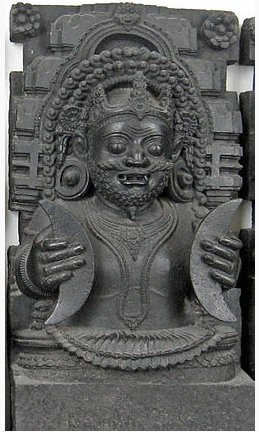2. Allen: "In other lunar zodiacs [than the Euphratean] they were the Sogdian Marezānā, and the Khorasmian Ikhma, the Twins; the Persian Avecr, the Coronet; and the Coptic Klusos, Watery. They also were the 3d manzil, Al Hak'ah; the siue Tsee, or Tsuy He, the Beak, or Pouting Lips, anciently Tsok, which Reeves gave as Keo; and the nakshatra Mrigaciras, or Mrigacirshā, the Head of the Stag, - Soma, the Moon, being its presiding divinity, and λ the junction star towards Ārdrā, and its determinant. As to the lunar station Professor Whitney very reasonably wrote: It is not a little strange that the framers of the system should have chosen for marking the 3d station this faint group, to the neglect of the brilliant and conspicious pair β and ζ Tauri, the tips of the Bull's horns. There is hardly another case where we have so much reason to find fault with their selection." The explanation could be that it was meant to draw attention - an eyecatching insignificance could be a Sign. Makemson (in The Morning Star Rises): "375. Na Mata-o-Takero, the Eyes-of-Takero; a Tuamotuan name possibly for a close pair of stars [like] Lambda and Phi Orionis, since Takero is said to be Orion's Belt." The Head of the Stag (Mrigacirshā) could refer to the Babylonian Stag constellation, and the Head of the Stag (or Deer) is the 5th nakshatra of 27:
I have blackmarked Betelgeuze not only because of my earlier suggestion that it represents a 'house' inside which it will be dark but also because of the astronomical significance of its ruling planet Rahu (which I have not discovered until now): "In Hindu tradition, Rahu is a cut-off head of an asura, that swallows the sun or the moon causing eclipses. He is depicted in art as a serpent with no body riding a chariot drawn by eight black horses ... According to legend, during the Samudra manthan, the asura Rahu drank some of the divine nectar. Sun and moon realized it and they alerted Mohini (the female avatar of Vishnu). Before the nectar could pass his throat, Mohini cut off his head. The head, however, remained immortal. It is believed that this immortal head occasionally swallows the sun or the moon, causing eclipses. Then, the sun or moon passes through the opening at the neck, ending the eclipse ... Rahu is a legendary master of deception who signifies cheaters, pleasure seekers, operators in foreign lands, drug dealers, poison dealers, insincere & immoral acts, etc. It is the significator of an irreligious person, an outcast, harsh speech, logical fallacy, falsehoods, uncleanliness, abdominal ulcers, bones, and transmigration ..." (Wikipedia)
I do not regard it as a coincidence that the word for soot in Polynesian is garahu, because I read it as ga-rahu, i.e. plural of rahu:
|
